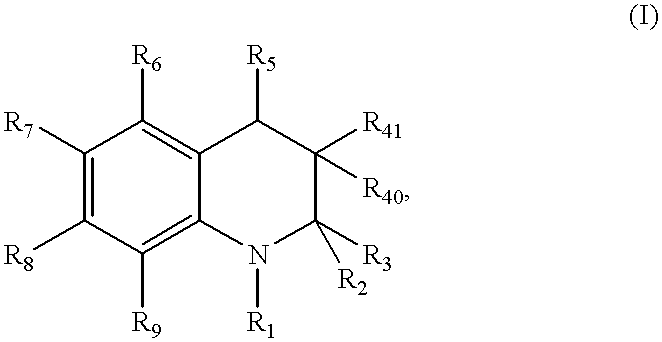Dihydro- and tetrahydro-quinoline compounds
a technology of tetrahydroquinoline and dihydroquinoline, which is applied in the direction of biocide, drug composition, cardiovascular disorder, etc., can solve the problems of less and less efficient natural defences, and achieve the effect of opporating the dopaminergic defici
- Summary
- Abstract
- Description
- Claims
- Application Information
AI Technical Summary
Benefits of technology
Problems solved by technology
Method used
Image
Examples
example 2
6-Ethoxy-5,7,8-trimethyl-1,2-dihydroquinoline-2-spirocyclohexane hydrochloride
Step 1:
N-(4-Ethoxy-2,3,5-trimethylphenyl)-N-[1-(1-ethynyl)cyclohexyl]amine
The expected product is obtained according to the procedure described in Step 1 of Example 1, starting from the compound described in Preparation A.
Step 2:
6-Ethoxy-5,7,8-trimethyl-1,2-dihydroquinoline-2-spirocyclohexane hydrochloride
The expected product is obtained according to the procedure described in Step 2 of Example 1, starting from the compound described in the above Step.
The corresponding hydrochloride is obtained by precipitation from an ether / dichloromethane mixture to which ethereal hydrogen chloride is added.
Melting point: 158.degree.-161.degree. C. (Et.sub.2 O / CH.sub.2 Cl.sub.2); Elemental microanalysis (empirical formula: C.sub.19 H.sub.27 NO.HCl).
example 3
8-Ethoxy-1,2-dihydroquinoline-2-spirocyclohexane hydrochloride
Step 1:
N-(2-Ethoxyphenyl)-N-[1-(1-ethynyl)cyclohexyl]amine
The expected product is obtained according to the procedure described in Step 1 of Example 1, with replacement of the p-phenetidine by o-phenetidine.
Step 2:
8-Ethoxy-1,2-dihydroquinoline-2-spirocyclohexane hydrochloride
The expected product is obtained according to the procedure described in Step 2 of Example 1, starting from the compound described in the above Step. The corresponding hydrochloride is obtained by precipitation from an ether / dichloromethane mixture to which ethereal hydrogen chloride is added.
Melting point: 154.degree.-155.degree. C. (Et.sub.2 O / CH.sub.2 Cl.sub.2); Elemental microanalysis (empirical formula: C.sub.1.sub.6 H.sub.21 NO.HCl).
example 4
5,7-Diisopropyl-6-ethoxy-1,2-dihydroquinoline-2-spirocyclohexane hydrochloride
Step 1:
N-(3,5-Diisopropyl-4-ethoxyphenyl)-N-[1-(1-ethynyl)cyclohexyl]amine
The expected product is obtained according to the procedure described in Step 1 of Example 1, using as starting material the compound described in Preparation B.
Step 2:
5,7-Diisopropyl-6-ethoxy-1,2-dihydroquinoline-2-spirocyclohexane hydrochloride
The expected product is obtained according to the procedure described in Step 2 of Example 1, starting from the compound described in the above Step.
Melting point: 166.degree.-169.degree. C. (with decomposition; Et.sub.2 O); Elemental microanalysis (empirical formula: C.sub.22 H.sub.33 NO.HCl).
PUM
| Property | Measurement | Unit |
|---|---|---|
| temperature | aaaaa | aaaaa |
| temperature | aaaaa | aaaaa |
| temperature | aaaaa | aaaaa |
Abstract
Description
Claims
Application Information
 Login to View More
Login to View More - R&D
- Intellectual Property
- Life Sciences
- Materials
- Tech Scout
- Unparalleled Data Quality
- Higher Quality Content
- 60% Fewer Hallucinations
Browse by: Latest US Patents, China's latest patents, Technical Efficacy Thesaurus, Application Domain, Technology Topic, Popular Technical Reports.
© 2025 PatSnap. All rights reserved.Legal|Privacy policy|Modern Slavery Act Transparency Statement|Sitemap|About US| Contact US: help@patsnap.com



